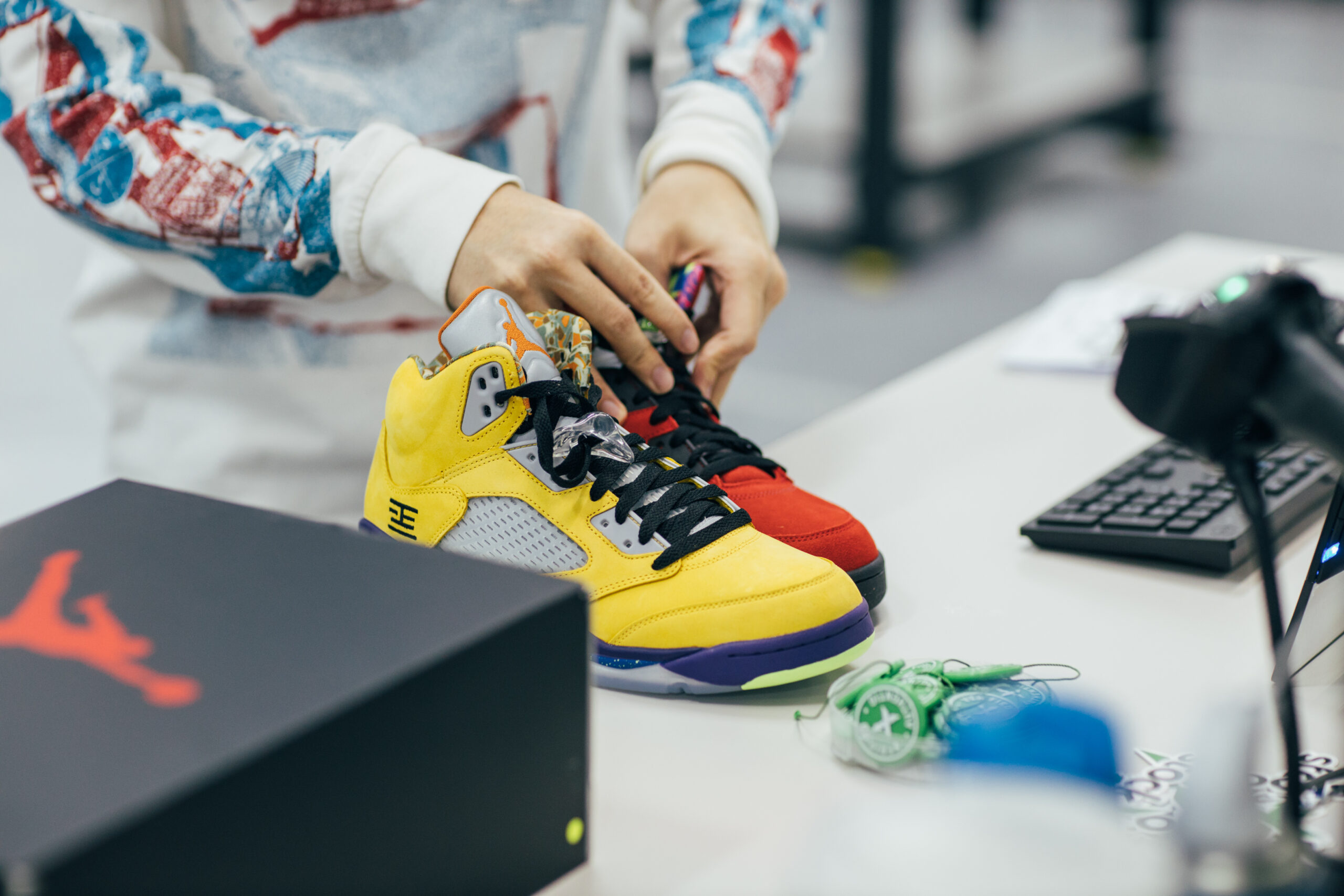We caught up with StockX’s Authenticator Chad B and their Senior Economist Jesse Einhorn to learn more about StockX, their authentication process, the growing trend in investing in the sneaker buying/reselling industry.
StockX’s mission is to provide access to the world’s most coveted items in the smartest way possible.
Authentication is at the core of the StockX experience and has long set the industry standard. In many respects, StockX created the job category of “sneaker authenticator” and, as part of that process, outlined a bespoke training program that each of their authenticators complete before hitting the floor. Chad is one of the first Canada-based authenticators to join StockX.

How does Stock X authenticate products?
CHAD: We only sell dead stock meaning it’s 100% not worn and of course, it has to be authentic. We’ve been a leader in the game and as such, we have a great team of trainers who go through an extensive, multi-month process before getting on the floor.
The process is very detailed, we start at the box before even touching the product. With the product we’re looking at the stitching, the sizing, the seams, and glue. After that, we look at the tags and accessories.
What sparked your interest in sneakers and how did you get involved in the community?
CHAD: In the past few years, the community has definitely expanded exponentially. I started collecting in 2011. The first shoe I lined up for was the Concord 11s. What really started my interest was my love of sports—especially basketball.
Jesse, tell us a little about being StockX’s senior economist?
JESSE: As StockX’s senior economist, I’m responsible for analyzing and synthesizing StockX data for the purpose of public-facing storytelling. Much of my day-to-day is spent finding meaning behind the numbers, monitoring price changes and emerging trends, and then communicating those insights to the public through StockX data reports (which come out every month) and blog posts.
It’s a bit like being a financial analyst, but instead of traditional stocks and bonds I’m watching the performance of Jordan 4s and KAWS figures.
As the resale business sees a rise in popularity, a new generation of consumers, collectors and investors are seeking out nontraditional investment opportunities, which is fuelling the convergence of consumer goods and tradable assets. Tell us a little about this next-gen investment business and the growing importance of alternative asset classes?
JESSE: As the next generation looks to build wealth, they aren’t just focusing on the stock market – they’re also looking to StockX to make investments in physical products like sneakers, collectibles and apparel.
And these products aren’t just vehicles for profit; they also hold cultural significance and meaning.
Since its inception, StockX has viewed and pioneered the trade of sneakers as an asset class and now applies these mechanics to streetwear, trading cards, collectibles, electronics and, most recently, art prints.
Purchasing a pair of Jordan’s isn’t just about fashion; more and more, we’re seeing consumers purchase products with future return in mind. A recent survey conducted by The Harris Poll on behalf of StockX found that nearly one in four US adults (23%) have purchased or plan to purchase limited-edition sneakers in 2021, and among them, 37% are motivated by the investment opportunity. Similarly, more than four in 10 American adults agreed future worth/investment value was a top consideration when purchasing collectibles in the past.
What are some overall trends in next-gen investing that you’ve seen?
JESSE: Individuals have been reselling sneakers for profit for decades, but up until recently the mass public didn’t recognize the size and scale of this market. Thanks in part to the increased access and awareness platforms like StockX have brought to the category, this once obscure idea has ballooned into a respected side hustle and profession.
We’re also seeing this trend of nontraditional, passion-led investmenting permeate other product categories like trading cards and collectibles.
In 2020 we saw a massive increase in people looking to collect and invest in trading cards. The “nostalgia effect” — a term we use to describe consumers’ increased interest in products with ties to childhood — was a big factor, and interest remains high even a year later. The surge in demand was matched by a corresponding rise in resale values. StockX saw triple-digit price growth across our most nostalgic product categories: Pokemon cards saw a +300% gain year over year, basketball cards rose 260%, and baseball cards rose 130%. Meanwhile, the amount of money spent on Bearbrick figures grew 275%.
With the exponential rise of non-traditional investments and new, burgeoning alternative assets, it’s clear today’s consumer is driving an incredible shift in mindset – this trend is here to stay.
What sets StockX apart from other resale sneaker companies?
CHAD: I think StockX really started the whole sneaker authenticator thing. We set the standard for other brands. We’re kind of the pioneer.
What’s one thing you’d caution people looking to get into this non-traditional investment business?
JESSE: While investing in alternative asset classes is uncharted territory for many, it’s important to note that many of the products on StockX provide better returns and are more stable than traditional stocks and bonds. We recently looked at the price appreciation of four popular product types — Air Jordan 4s, Nike Air Max 1s, KAWS figures, basketball trading cards — and found that all four of these StockX indexes outperformed the S&P 500 between January 2020 and May 2021 . With the exception of trading cards, these StockX products are also less volatile. While basketball cards have seen large swings in value, Jordan 4s and Air Max 1s and collectible figures from KAWS tend to see steady, consistent appreciation over time.
Like any other investment, it pays to do your research. We publish a ton of great market analysis – for example, identifying which Jordan 1 models see the greatest price appreciation, or why Bad Bunny collabs are a savvy investment right now. You should also leverage the data provided on StockX product pages, including historical sales and pricing trends.
How can people leverage StockX to its fullest when getting into this business?
JESSE: StockX gives consumers unprecedented market visibility, and we want people to take advantage of all that data. Leverage the metrics we publish, like price premium, average sale price, volatility, and 12-month sales history. By doing so, you can understand the true market value of products and make informed buying and selling decisions.
Apart from buying and selling on the platform, millions of consumers around the world trust StockX as the authority on pricing for current culture products. Even CEOs of major brands reference StockX’s pricing data to track brand heat and manage supply levels.


